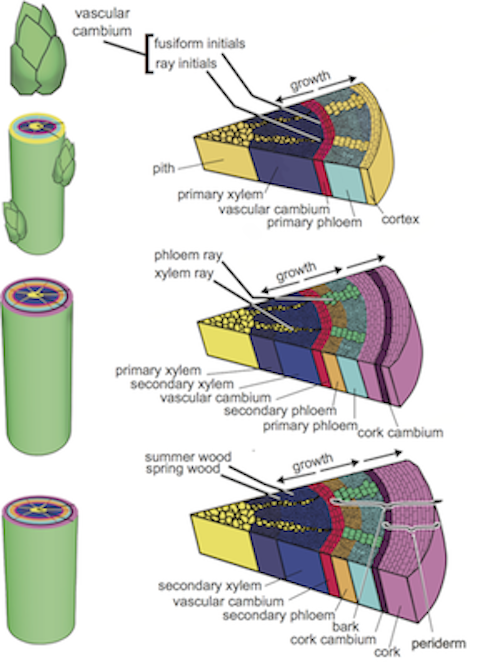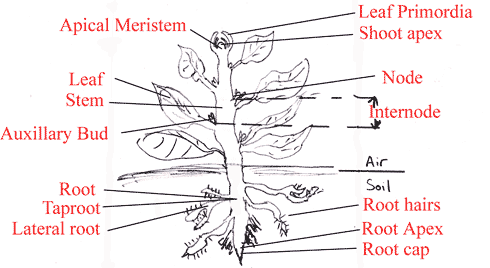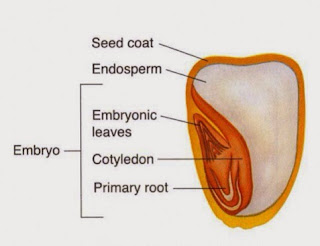Water and nutrients are transported through plants first through turgor pressure in which the water is fist absorbed. The soil is the source of all nutrients the plant needs which the roots soak up. Water is then transported from the roots through the rest of the plant via the xylem. Any waste is then secreted through the stomata through a process called Transpiration. The casparian strip projects the plant from losing too much water at one time.
Terms
1. Turgor Pressure- the absorption of water into the vacuoles in the cells.
2. Transpiration- process in which water is released by the plant through the stomata.
3. Xylem- tissue which transport water from the roots
4. Stomata- pores in the plant made up of guard cells which release water and other wastes such as oxygen
5. Casparian strip- blocks the passive flow of water and other wastes from leaving the plant.
Wednesday, March 26, 2014
Growth of Plants: Shooting and Rooting!
My plants are currently around the stage called shoot and root. Meristem is a part of plant tissues which are in charge of growing roots and shoots in order for cells to divide and the plant to grow. In order for cells to divide, they need the hormone cytokinin which stimulates the division of cells for the growth of roots, shoots, and flowers. There are two types of growth:
1. Primary- Growth of the plant will exceed above and below ground. The shoot will appear when the tip of the stem is visible from the top of the soil. Growth will continue to occur upward, but not much more below. Roots on the other hand will travel downward into the soil and get hold of the ground in order to absorb nutrients for the shoot. It will grow straight downward and can grow out to the sides after its first shoot down. The hormone auxin is involved in both shooting and rooting which is in charge of plant elongation.
2. Secondary- The shoots will now begin to grow outward as well as upward. This can be seen in the image below. Gibberellins is the hormone responsible for plant growth upwards and outwards.

Vascular cambium is the think ring formed around the plant. On trees this is the bark which will scuff off very now and then.
Tropism is the movement of the plant depending on environmental factors. An example of this would be the plant facing towards the sunlight instead of away in order to absorb as much light as possible.
1. Primary- Growth of the plant will exceed above and below ground. The shoot will appear when the tip of the stem is visible from the top of the soil. Growth will continue to occur upward, but not much more below. Roots on the other hand will travel downward into the soil and get hold of the ground in order to absorb nutrients for the shoot. It will grow straight downward and can grow out to the sides after its first shoot down. The hormone auxin is involved in both shooting and rooting which is in charge of plant elongation.
2. Secondary- The shoots will now begin to grow outward as well as upward. This can be seen in the image below. Gibberellins is the hormone responsible for plant growth upwards and outwards.

Vascular cambium is the think ring formed around the plant. On trees this is the bark which will scuff off very now and then.
Tropism is the movement of the plant depending on environmental factors. An example of this would be the plant facing towards the sunlight instead of away in order to absorb as much light as possible.
Tuesday, March 25, 2014
Growth Update
My babies are really starting to grow! There appears to be three sprouts from Louis the carrot plant, and one sprout from Larry the corn plant. Could not be a prouder parent :)
Louis Larry
Monday, March 24, 2014
Structure of Young Plants
Below is a diagram of the basic structures of a young plant.

Some of the most important structures include:
1. Terminal bud- located at the tip of the stem (see bud)
2. Node/internode- holds the buds which branch off as leaves, roots, or stems
3. Cotyledon/coleoptile- beginning of the first leaves which will appear on the plant
4. Adventitious/tap root- root growing downward which the roots will grow off of
5. Primary/lateral root- root growing horizontal from the tap root which will stabilize the plant into the soil.
6. Root hairs- growth from the roots which will absorb nutrients and water from the soil
7. Leaf- blade which will grow from the stem which will play a key role in photosynthesis later on
8. Cuticle/dermal tissue- the protective covering on the dermal tissue of the leaves made of lipids and often waxy

Some of the most important structures include:
1. Terminal bud- located at the tip of the stem (see bud)
2. Node/internode- holds the buds which branch off as leaves, roots, or stems
3. Cotyledon/coleoptile- beginning of the first leaves which will appear on the plant
4. Adventitious/tap root- root growing downward which the roots will grow off of
5. Primary/lateral root- root growing horizontal from the tap root which will stabilize the plant into the soil.
6. Root hairs- growth from the roots which will absorb nutrients and water from the soil
7. Leaf- blade which will grow from the stem which will play a key role in photosynthesis later on
8. Cuticle/dermal tissue- the protective covering on the dermal tissue of the leaves made of lipids and often waxy
Saturday, March 22, 2014
Friday, March 21, 2014
Wednesday, March 19, 2014
Sunday, March 16, 2014
Germination
My babies' growth begins right away with Germination. Germination begins right when the seeds are subject to water. Of course, I gave my babies a good drink right when I got them home. As long as the proper temperature and sunlight exposure is also provided, germination will begin day one. At this time, energy is also collected and stored to be used later on to grow big and strong. Once my babies' embryos drink up enough water, a root will appear, called a radicle. The cotyledon gives the seedlings nutrients before it can actually receive them from the soil. In the photo below, germination is shown with the radicle appearing in the soil.
Saturday, March 15, 2014
Seed structure
As of right now my babies are just little seeds. I would like to provide you with some background information on what my babies are like as of today.
Corn seed ^
Carrot seed ^
Above are some photos of what my babies look like on the inside with a nice diagram pointing to the different structures within. First is the embryo. The embryo of the seed will emerge with germination (I will further discuss germination in another post!) in which the embryo will grow out of the seed and begin to sprout. Next is the cotyledon. The cotyledon is actually part of the embryo which becomes the leaves. The final major component of the seeds is the endosperm. The endosperm is a tissue which surrounds the embryo and comes into play in further development by storing nutrients.
Friday, March 14, 2014
The babies are here!
Today was a huge day for me! I have just adopted two baby plants! One is a carrot plant named Louis and the other is a corn plant named Lenny. I am so excited to document their growth here and show you their development every step of the way! Stay tuned for more updates!
Subscribe to:
Posts (Atom)








